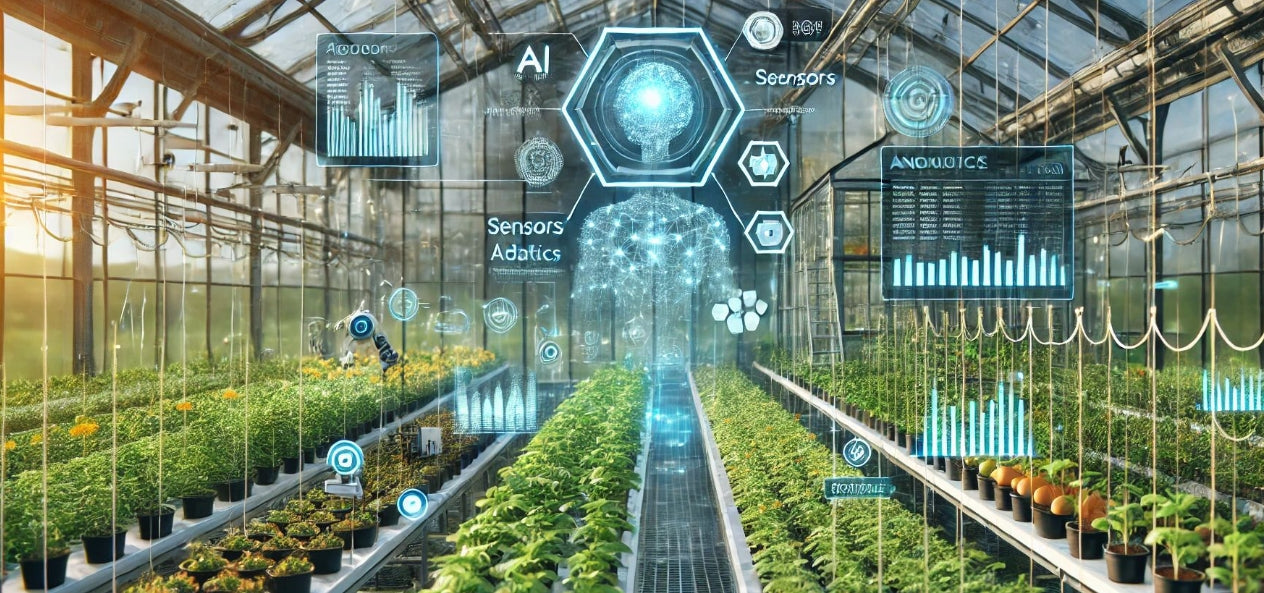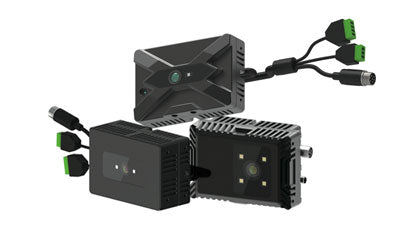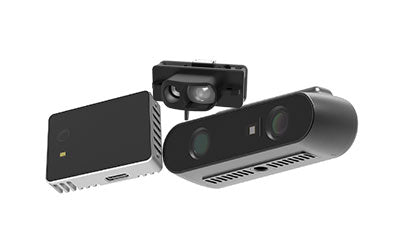Future Value of TOF in Smart Agriculture: Making Land 'Understandable'

As global agriculture moves toward intelligent and sustainable transformation, TOF (Time of Flight) sensing technology is quietly becoming a key driver in the revolution of precision farming. With TOF 3D imaging, farmland is no longer just a vague patch of 'green' — it becomes a visible, analyzable, and precisely manageable data asset. From soil monitoring to greenhouse crops, from ground-based robots to aerial drones, TOF technology is ushering in a new era where agriculture can truly 'understand the land.'
1. Smart Agriculture and the Rise of Precision Farming
In recent years, due to climate change, population growth, and labor shortages, traditional extensive farming methods can no longer meet the demands of global food security and sustainable development. This has given rise to Precision Agriculture, which leverages sensors, big data, AI, and robotics to enable on-demand crop management, optimal resource allocation, and maximum yield.
Devices like TOF 3D cameras, RGB-D cameras, and LiDAR serve as the 'eyes' of modern machines in precision agriculture, providing real-time spatial data and accelerating the adoption of 3D vision systems in agricultural scenarios.
What is a 3D Vision System?
A 3D vision system uses devices such as cameras, LiDAR, and TOF sensors to capture the 3D spatial information of objects. It records depth, shape, and volume to generate point clouds or 3D images, which are used for tasks like object recognition, positioning, measurement, and navigation.
In industries such as automation, smart warehousing, robotics, and autonomous driving, 3D vision systems are widely used for:
-
Object detection and classification: identifying various shapes and sizes of items
-
Path planning and obstacle avoidance: helping AGVs or robots move safely
-
High-precision positioning: enabling accurate gripping or stacking
-
Quality inspection: detecting defects, deformations, or misalignments
Compared to traditional 2D vision systems, 3D vision offers superior spatial perception, making it ideal for complex environments.
2. TOF for Soil Modeling, Crop Recognition, and Height Estimation: Accelerating the 3D Vision Upgrade in Agriculture
TOF (Time-of-Flight) 3D cameras emit infrared light and measure the time it takes to bounce back, enabling accurate capture of depth and 3D structural data. Compared to 2D imaging, TOF cameras offer high frame rates, real-time performance, high depth accuracy, and strong resistance to ambient light — making them highly suitable for the dynamic and complex conditions in agriculture. Key agricultural applications include:
1. Soil Surface Modeling and Terrain Recognition
TOF cameras can collect 3D point cloud data over large farmlands to model surface conditions and detect terrain undulations, slopes, or obstacles. These insights support:
-
Autonomous vehicle navigation such as AGV route planning
-
Precision operations like seeding, fertilization, and spraying
-
Topographic mapping for farmland improvement or drainage planning
2. Crop Identification and Smart Sorting
Combining TOF depth imaging with visible-light images and AI models (like deep learning classification and semantic segmentation), TOF systems can automate crop identification and sorting:
-
Distinguish crop species or varieties (e.g., tomatoes, peppers, strawberries)
-
Assess ripeness or health status to identify harvestable produce
-
Enable automated harvesting and grading using robotic arms
3. Plant Height and Volume Estimation
TOF’s precise 3D data supports monitoring crop growth patterns:
-
Real-time estimation of plant height and canopy volume
-
Building 3D models across different growth stages
-
Providing data for smart irrigation and variable-rate fertilization, enhancing precision farming
TOF 3D cameras are becoming the critical 'sensory neurons' for agricultural robots and automation equipment. Their accurate, real-time, and robust 3D perception is bringing 3D vision inspection from research labs directly into the fields — powering intelligent, automated, and efficient farming operations. Whether it's autonomous tractors, harvest robots, crop protection bots, or agricultural data modeling systems, TOF technology has vast potential.
3. TOF’s Spatial Intelligence in Greenhouse Monitoring and Plant Growth Tracking
In modern smart greenhouse systems, static sensors like temperature and humidity monitors are no longer sufficient for precision farming. As spatial sensing technology advances, TOF 3D cameras are emerging as key tools in building 'spatial intelligence' in agriculture. With high-accuracy depth perception, TOF cameras provide dynamic, three-dimensional, real-time monitoring for greenhouse management — particularly in the following areas:
1. Real-Time Plant Monitoring and Growth Tracking
TOF cameras can perform non-contact 3D scanning of plants daily, capturing structural details and growth trends to build time-series 3D models of plant development. This supports:
-
Automatic detection of plant height, leaf area index, and canopy volume
-
Early alerts for growth abnormalities or disease-related deformation
-
High-precision data for growth regulation or genetic research
Compared to traditional RGB images or manual observations, TOF delivers true 3D structure data, greatly improving monitoring precision and automation.
2. Dynamic Environmental Control
By detecting plant distribution and growth trends in real-time, TOF data helps control key greenhouse systems:
-
Automatically adjusting LED lighting height and angle to avoid shading or energy waste
-
Precisely managing sprinkler positions and water flow based on plant volume
-
Coordinating with fans or HVAC for localized ventilation and temperature regulation
TOF cameras enable a shift from 'environmental parameter control' to 'plant response–driven spatial adjustments', better matching actual crop needs.
3. Target Area Detection and Localized Operations
In automated greenhouse tasks, TOF 3D sensing gives robots “eyes” to:
-
Accurately locate specific plants for spot spraying, pruning, or sampling
-
Navigate with path planning and obstacle avoidance on AGVs or robotic arms
-
Create a digital twin of the greenhouse for remote monitoring and management
Especially in multi-layer cultivation or high-density greenhouses, TOF’s high-resolution depth sensing solves recognition challenges caused by occlusion or lighting changes.
TOF technology is advancing from static monitoring to spatial-level intelligent perception, becoming a core sensing module in smart greenhouse systems. When combined with environmental sensors, TOF not only enhances automation and precision in greenhouse management but also builds a plant growth–centric spatial intelligence ecosystem — providing strong support for both production efficiency and crop quality improvement.
IV. TOF Empowers Integrated Aerial-Ground Agricultural Perception Systems: Intelligent Collaboration Between Drones and Ground Robots
In the vision of smart agriculture, the synergy between aerial and ground perception systems is becoming a core trend. To achieve large-scale, high-precision, and dynamically responsive monitoring and operational control of agricultural environments, TOF (Time-of-Flight) cameras are being deeply embedded into both agricultural drones and ground robots. With their high resolution, real-time capabilities, and resistance to interference, TOF cameras are driving the convergence of 3D perception systems and intelligent decision-making platforms.
1. Agricultural Drone + TOF + 3D SLAM Navigation: Building Aerial Digital Farm Models
Integrating TOF cameras into agricultural drones and combining them with 3D SLAM (Simultaneous Localization and Mapping) technology enables:
-
Real-time 3D mapping of fields: Capturing crop height variation, terrain undulation, and obstacle locations to provide spatial geographic data for precision farming;
-
Dynamic crop growth analysis: Fusing depth maps with infrared imaging to assess growth density, health status, and maturity across different regions;
-
Assisting route planning and obstacle avoidance: Especially in complex terrain or greenhouses, TOF depth data supports precise avoidance, ensuring stable drone operation.
Compared to traditional monocular or LiDAR systems, TOF cameras offer stable and continuous depth perception even under strong light, low light, or nighttime conditions, greatly enhancing drones’ adaptability to diverse environments.
2. Ground Robot + TOF Vision + RGB-D Fusion: Achieving High-Precision Operation and Navigation
Ground robots (such as AGVs and harvesting robots) rely on environmental perception systems for path planning and fine operations. TOF 3D vision systems can:
-
Generate dense depth point clouds, which, fused with RGB images, form RGB-D data to improve object recognition and pose estimation accuracy;
-
Enable precise seeding, spraying, weeding, and harvesting through accurate position identification and alignment operations;
-
Support navigation and dynamic obstacle avoidance in complex terrains—such as uneven, wet, or obstacle-filled farmland—ensuring stable performance.
With TOF systems, ground robots can not only 'see' their surroundings but also 'understand' crop status and field conditions, allowing them to execute more sophisticated tasks.
3. Cross-Platform TOF Data Fusion: Building an Integrated Aerial-Ground Crop Monitoring Model
In collaborative aerial-ground agricultural systems, TOF cameras on drones and ground robots respectively collect depth and crop condition data. Through coordinate unification and perception data fusion, the system can:
-
Construct a seamless and continuous 3D digital twin model of the farm;
-
Enable spatiotemporally aligned crop monitoring, pest tracking, yield prediction, and resource scheduling;
-
Overlay multi-source sensor data (e.g., temperature, humidity, light, soil pH) onto the 3D map to enhance the intelligence and responsiveness of agricultural decision systems.
This collaborative approach of 'seeing from the sky, acting from the ground' unlocks TOF’s full potential in both dimensions, delivering a leap in capability through global vision and local precision control.
4. TOF's Core Value in 3D SLAM Navigation Systems
Achieving efficient SLAM navigation in agricultural settings—particularly in unstructured terrains like ridges, hills, and orchards—requires precise mapping and localization. TOF cameras offer key advantages:
-
High-frame-rate real-time data streams: Meeting SLAM’s stringent requirements for continuity and time synchronization;
-
Millimeter-level depth resolution: Enhancing feature extraction and matching accuracy for improved localization;
-
Strong resistance to sunlight interference: Ensuring stable outdoor operation even in bright daylight;
-
Low power consumption and compact design: Compatible with various mobile platform deployment needs.
Therefore, TOF is not only the foundation for machine “vision” in agriculture but also the key enabler of intelligent motion and environmental understanding.
TOF technology is accelerating the evolution of agricultural perception systems from 2D imagery to 3D intelligent spatial reconstruction. Its wide application in drones and ground robots is improving the precision and reliability of automation, while laying the foundation for an integrated, intelligent agricultural ecosystem.
V. TOF Drives Green Agriculture Perception Innovation: Toward a Sustainable, Data-Driven Ecosystem
Future agriculture is rapidly moving beyond traditional models toward data-driven, intelligent, and ecologically friendly systems. In this transformation, advanced sensing technologies like TOF (Time-of-Flight) are becoming core engines of green agricultural reform. With its high-precision 3D imaging, real-time data acquisition, and environmental adaptability, the TOF camera integrates deeply with AI algorithms and IoT systems, ushering agriculture into a new era of precision, efficiency, and sustainability.
1. Precision Targeting to Reduce Pesticide Waste and Environmental Pollution
Traditional spraying methods often adopt broad-area coverage, leading to resource waste and potential soil and water pollution. With TOF cameras mounted on drones, spray arms, or AGVs, the system can:
-
Accurately identify crops and pest-affected areas: TOF depth maps assist AI in locating abnormal leaves or pest hotspots;
-
Precisely control spray dosage and location: Apply pesticides only where needed, avoiding unnecessary coverage;
-
Significantly reduce total pesticide usage: Improve treatment efficiency while minimizing ecological impact.
This approach not only reduces production costs but also meets the pressing demand for eco-friendly agricultural technologies.
2. Smart Regulation for Optimal Water and Fertilizer Use
TOF-enabled 3D crop height, canopy width, and terrain data, when combined with temperature, humidity, and soil moisture sensors, supports intelligent irrigation and fertilization decisions:
-
Identify uneven crop growth zones: Determine water and nutrient imbalances and avoid resource waste;
-
Dynamically adjust irrigation systems: Drip and spray systems can be fine-tuned based on crop water demand;
-
AI-optimized nutrient delivery plans: Achieve maximum yield and quality with minimal input.
Using TOF-generated spatial information, agricultural resources can be precisely deployed and differentially allocated, turning the theory of resource efficiency into practical, intelligent action.
3. Replacing High-Carbon Machinery: Transitioning to Low-Carbon Farming
Traditional agricultural machines are mostly fuel-powered, emitting large amounts of CO₂ and negatively impacting the environment. TOF-enabled electric AGVs, autonomous harvesters, and seeding robots are gradually replacing them:
-
Autonomous path planning and obstacle avoidance: TOF provides real-time 3D maps to ensure efficient operations;
-
Enhanced operational accuracy, reduced redundancy: Minimizes energy waste and repetitive tasks;
-
Integration with clean energy sources: Such as solar-powered charging stations, enabling net-zero operation.
These smart TOF-equipped devices are becoming the main force of agriculture’s carbon-neutral transition, helping to build environmentally friendly production chains.
4. From 'Weather-Dependent' to 'Data-Driven' Farming
As a leading time-of-flight ranging technology, TOF is redefining the boundaries of agricultural perception. It gives machines not only 'vision,' but also the ability to collaborate with AI, cloud computing, and big data to enable:
-
All-weather 3D sensing: Resilient to light interference and suitable for greenhouses, open fields, drylands, and paddies;
-
Real-time dynamic monitoring: Supporting periodic growth tracking, disaster alerts, and remote data collection;
-
Closed-loop intelligent decision-making: Seamlessly integrating perception, analysis, and execution into a 'sense-and-act' automation cycle.
Ultimately, farming shifts from reliance on 'experience' and 'favorable weather' to a data-centered, algorithm-driven smart paradigm.
Conclusion: TOF Ushers in a New Era of Agricultural Perception
The future of green agriculture is not built in isolation—it is shaped by an ecosystem of sensor networks, AI intelligence, big data management, and automation control. Within this ecosystem, TOF technology, as the core node of 3D perception, not only delivers high-precision environmental insights but also injects sustainable momentum into agricultural development.
From 'blurred vision' to 'clear understanding,' from 'broad application' to 'targeted precision,' TOF is leading agriculture into a new era of green intelligence, enabling deep integration between humanity and nature, technology and farming.
Summary: The TOF-Powered Era Where Land 'Understands' Itself
Whether it’s a 3D TOF camera for agricultural perception or a 3D vision system with SLAM for agri-robots, TOF technology is providing foundational spatial sensing for smart agriculture. In the future, TOF will merge with semiconductors and cutting-edge chips (2024), ROS robotics platforms, and AI analytics models, accelerating agriculture toward an era of ubiquitous connectivity and full-domain perception.
Synexens Industrial Outdoor 4m TOF Sensor Depth 3D Camera Rangefinder_CS40p
After-sales Support:
Our professional technical team specializing in 3D camera ranging is ready to assist you at any time. Whether you encounter any issues with your TOF camera after purchase or need clarification on TOF technology, feel free to contact us anytime. We are committed to providing high-quality technical after-sales service and user experience, ensuring your peace of mind in both shopping and using our products.






